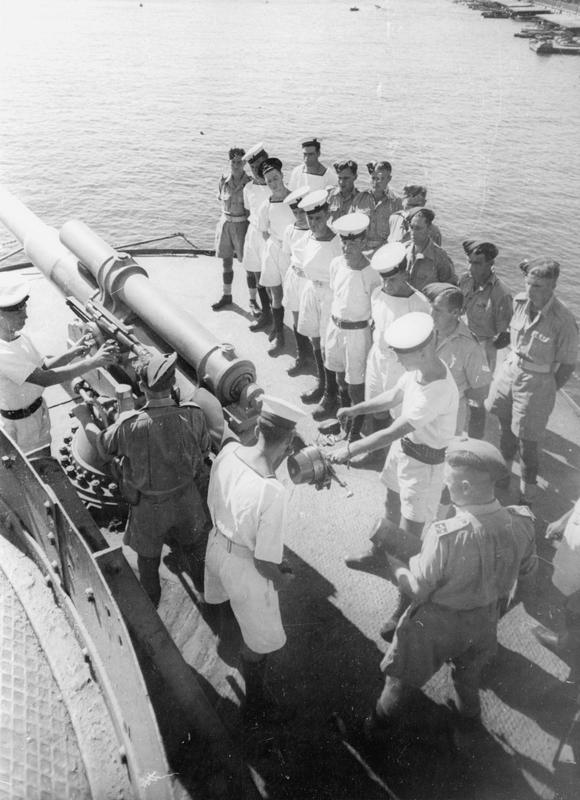
These were Elswick guns of Pattern Y that were designed for export, with guns being supplied to the Argentine, Chinese and Norwegian navies, among others, during the late 1800s and early 1900s. Seven of these Elswick guns were acquired for British coast defense in 1900 and designated by the Royal Navy as the Mark V.
The Mark V* was a similar gun ordered by the Royal Navy from Japanese factories for use on DAMS during World War I. These guns were considered to be obsolescent even when new, as they still used a screw breech but fired separate ammunition. Many of these guns survived in storage until World War II when they were then used on a few auxiliary warships and some large liners but primarily on DEMS.
In certain conditions the striker protruded so much that it was possible for the gun to fire before the breech was closed.
Both the Mark V and the Mark V* were built up guns consisting of A tube, breech piece, two B tubes, jacket and short breech ring. Both guns used a single-motion breech block which on the Mark V was held by the breech piece but on the Mark V* was held by a breech bush screwed into the jacket. Of the 620 Mark V* guns supplied by Japan, 24 were lost in transit and two were used for coast defense at Trinidad. 525 of these guns remained as of 1939.
Actual bore length was 43.92 calibers.
The 4.7" (12 cm) caliber was used on almost every destroyer built by Britain between 1917 and 1943.
Actual bore diameter of all British 4.7" guns was 4.724" (12 cm).
The data that follows is for the Mark V* unless otherwise specified.
| Designation | 4.7"/45 (12 cm) Mark V and Mark V* |
|---|---|
| Ship Class Used On | Mark V: Coast Defense Mark V*: DAMS, TGBs Haycyon and Hamadryad World War II: A few warships, liners including Aquitania and DEMS |
| Date Of Design | Mark V: About 1895 |
| Date In Service | Mark V: 1900 as coast defense Mark V*: about 1915 |
| Gun Weight | 5,937 lbs. (2,693 kg) |
| Gun Length oa | 212.6 in (5.400 m) |
| Bore Length | 207.5 in (5.271 m) |
| Rifling Length | 179.2 in (4.202 m) |
| Grooves | 26 polygroove, plain section |
| Lands | N/A |
| Twist | Straight from breech to 150.9 in ( 3.833 m) from muzzle, then increasing to RH 1 in 30 at 8.2 in (20.8 cm) from muzzle, then uniform RH 1 in 30 |
| Chamber Volume | 489.6 in3 (8.02 dm3) |
| Rate Of Fire | 8 - 10 rounds per minute (?) |
| Type | Separate |
|---|---|
| Projectile Types and Weights |
|
| Bursting Charge | Common: 6.84 lbs. (3.1 kg) Others: N/A |
| Projectile Length | N/A |
| Propellant Charge | World War I: 8.67 lbs. (3.93 kg) MD 16 World War II: 8.65 lbs. (3.92 kg) SC103 |
| Muzzle Velocity | 2,330 fps (710 mps) |
| Working Pressure | N/A |
| Approximate Barrel Life | N/A |
Brass case with propellant weighed 26.5 lbs. (12 kg).
Data from:
- "Naval Weapons of World War Two" and "British Naval Guns 1880-1945 No 15" article in "Warship Volume IX" both by John Campbell
Special help from Anthony G. Williams and Shane Rogers
- 07 January 2008
- Benchmark
- 16 January 2016
- Added photograph
